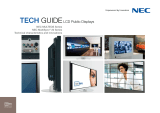
Displays—What displays are ideal for this situation?
o Higher ambient lighting would cause for higher brightness screens
NEC offers both commercial brightness and professional brightness screens depending
on what’s necessary
o Are ultra-narrow bezel units necessary?
NEC offers displays with active area to active area distances as low as 5.5mm
Ventilation/Cooling—Make sure that the wall is receiving proper ventilation behind the units.
o All NEC V, P and X series displays have temperature sensors built into the units.
There are three sensors total, aligning themselves with 2 internal fans
These sensors are used to measure the temperatures within certain hotter parts of the
display.
Once a sensor hits its ‘trip’ point, it triggers fans to turn on and stay on until the
temperature is under a certain threshold.
o As a rule of thumb, if an increase of 10º C is seen when a unit is installed compared to a
single stationary unit, extra active cooling needs to be added.
Power—Make sure that there’s enough power planned into the design for all video wall components.
Receiving
When the units are first received, be sure to notate any boxing damage
o If damage is present, be sure to take pictures of the shipping damage
Always inspect the units when first receiving them.
o Note that the mechanical integrity of the product is not compromised.
o Be sure to plug the product in, make sure the unit turns on
Be sure to hit the ‘hard power’ switch on the back to do this
Notate any cracks or scratches on the front glass
o Take pictures of any damage or defect
Contact your distributor with any DOA or damaged goods claims to start the MRA processing
Installing
If this is going on a wall, make sure that it’s able to support to support the extra weight associated with
the screens and mounts.
o Building engineers should be able to help here. It’s almost always a good idea to support the
wall to hold the extra weight.
If using an adjustable mounting bracket, it’s always a good idea to ‘zero’ out the adjustment range before
installing individual monitors
o This makes fine-tuning and adjustment easier when the displays start going up




